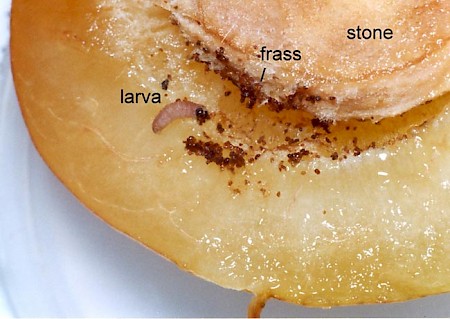Plum Fruit Moth Grapholita funebrana

49.357 BF1247
Plum Fruit Moth Grapholita funebrana
Treitschke, 1835
Wingspan 10-15 mm.
This species is locally common in the southern half of England with scattered records further north and in Wales, and a few in Scotland. It has been recorded at light, but records are more easily made by search for larvae in plums and sloes, and by assembling to pheromone lures.
The moths fly in June and July, usually high in the foodplant trees. They can easily be confused with Grapholita tenebrosana, especially as that species is also attracted to lures designed for G. funebrana, both species sometimes being found together in a trap. They can be separated by the colour of the palps; dull greyish brown in G. funebrana, greyish white on G. tenebrosana . The genitalia of the males are distinct.
The larvae feed on the fruits of sloe (Prunus spinosa), plum (Prunus domestica) and other Prunus species. The entrance hole, near the stalk on plums, often oozes brown liquid surrounded by frass. The feeding signs resemble those of the larva of the sawfly Hoplocampa flava (Linn.), so the fruit should be cut open to view the larva (The sawfly has ten pairs of prolegs.). In plums, the larva is usually found close to the stone. The early and intermediate instars have translucent white bodies and greyish prothoracic and anal plates. The final instar becomes deep pink, and the plates lose the grey pigment.
The larva leaves the fruit in late August or September, and overwinters in a spun hibernaculum. At this stage it is pale reddish yellow with a reddish dorsal line.
Pupation, in the soil or a suitable crevice, is in April and May.

 UKMoths
UKMoths 






